Mike Vardy's Blog, page 62
March 27, 2017
The Productivityist Podcast: Zen and The Art of Work with Kourosh Dini
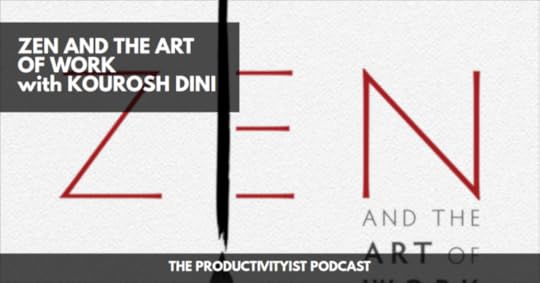
My guest for this episode is Kourosh Dini – a psychiatrist, writer, musician, and author. Some of his works include Zen & The Art of Work, Creating Flow with OmniFocus, and Workflow Mastery.
I’ve met Kourosh a couple of years ago when we worked together for the OmniFocus set-up. I love his work and have always seen him as a thoughtful productivity strategist who knows his stuff.
Some of the things we talked about this week are:
How meditation shifts our mindset which ultimately makes us more mindful and productive (3:04).
The importance of pausing and practical tips on how to apply it in your life (4:55).
Personalization and why it’s important in your daily interactions (8:03).
Why play time is a necessary ingredient in performance, productivity, and happiness at work (11:26)
How music can boost your productivity, creativity, and overall sense of well-being (16:40).
Kourosh’s thoughts on ambient sound apps and how he uses them in his own workflow (20:05).
The five elements of good health, according to Kourosh (23:00).
Kourosh’s take on meditation and his recommendations for those who want to start meditating (24:05).
Relevant Links:
Kourosh Dini | Mind, Music, and Technology
Zen & the Art of Work | Find Calm in Work and Play
OmniFocus | Task management for Mac, iPad, and iPhone
Review: Zen and The art of Work | Productivityist
Productivity & Play with Dr. Kirsten Milliken | Productivityist
Focus at Will | Get 4x increase in productivity with this concentration music for working smarter.
So Good They Can’t Ignore You: Why Skills Trump Passion in the Quest for Work You Love by Cal Newport| Amazon
How to Meditate: A Guide to Self-Discovery by Lawrence LeShan| Amazon
What’s the Best Music to Listen to While Working? | The Atlantic
Kourosh Dini (@kouroshdini) | Twitter
Thanks for tuning in! Until next time, remember to stop guessing…and start going.
If you’re interested in supporting the podcast and receiving exclusive content while doing so, you’ll want to check out the patrons-only version of The Productivityist Podcast on Patreon. Also, remember to leave The Productivityist Podcast a rating and review on iTunes, or on whatever platform you’re listening to. I read every single bit of feedback we receive. I want to make this show better and with your help I can do just that.
The post The Productivityist Podcast: Zen and The Art of Work with Kourosh Dini appeared first on Productivityist.
March 23, 2017
3 Ways You Can Create An Effective Journaling Habit

You might be wondering how in the world journaling can help you attain more focused attention. Well, like the brain dump, journaling helps you clear your mind of stuff that is cluttering it. Journaling also lets you review regularly and stay on course instead of deviating from what your priorities are.
Some of the most successful people in history kept a daily journal. Here are just a few names you may recognize:
Jack Kerouac
Benjamin Franklin
Anais Nin
Andy Warhol
Franz Kafka
Ernest Hemingway
Mark Twain
George Lucas
Maria Popova of the popular blog Brain Pickings describes the benefits of keeping a journal as follows:
“Journaling, I believe, is a practice that teaches us better than any other the elusive art of solitude — how to be present with our own selves, bear witness to our experience, and fully inhabit our inner lives.”
Keeping a journal is, like the brain dump, not complicated. Here are some tips to start (and keep) an effective journaling habit:
Use a photo as a prompt for your journal entry. Whenever I journal, I use a photo from my day to act as a trigger to start the writing process. I have my smartphone with me all day and have gotten into the habit of taking a photo every day of something that stands out. I use that photo as a way to get the creative juices flowing. From there, I usually crank out 300 words or so that chronicle the highlights of my day. (If you don’t have an application on your computer or smartphone where you can type your journal, use the photo from your smartphone to inspire the writing in your paper journal anyway. Just describe the photo and you’ll find you’ll be on your way with a new entry.)
2. Add journaling to your morning routine. When you wake up first thing in the morning, tack on writing in your journal as part of the start of your day. It’s an excellent way to shape the day the way you want it to be. Julie Cameron, the author of The Artist’s Way, discusses her “morning pages” as something she does every morning. She simply writes whatever comes to mind and doesn’t judge what comes out of her head. She just writes. You could do the same thing.
3. Add journaling to your evening routine. I don’t journal in the morning because I refer to my to-do list and calendar to start my day. But I do journal in the evening before bed. Add writing your journal entry to your bedtime routine. The last thing I do before I brush and floss my teeth is write in my journal. It clears my mind of any residual ideas or thoughts about the day I may have and helps me get to sleep much faster. David Allen calls these “open loops,” and if you can close as many of them as possible in a journal entry before you go to bed, you may even have a more restful sleep.
If you’ve ever watched Star Trek, you know that the “captain’s log” was an essential part of every episode. The log described where the USS Enterprise had been, where it was currently, and where it was going. The log would help the crew course correct if they veered too far from their mission and also chronicle how they got off course in the first place.
Journaling can do the same for you. It can show your present self where you were and how you got to where you are now. Plus it can help you steer yourself in the right direction on an ongoing basis. That alone is going to be a great way to help you make progress on your priorities. The journal keeps your intentions in front of you, your attention focused, and your progress moving forward — instead of going off course.
The post 3 Ways You Can Create An Effective Journaling Habit appeared first on Productivityist.
March 21, 2017
A Spring Cleaning Checklist to Increase Your Overall Productivity

Today’s guest post is by Kacey Mya. Kacey is a lifestyle blogger for “The Drifter Collective.” She finds excitement in the world around her and this is portrayed through her visually pleasing, culturally embracing and inspiring posts. You can connect with Kacey on Twitter, Pinterest or Instagram.
As much as you’re looking forward to the upcoming spring weather, you’re probably dreading the annual chore that comes with it — spring cleaning.
But before you dismiss this task as “just cleaning,” consider this: studies have proven that having a clean, uncluttered atmosphere not only improves your physical health, but it also boosts your overall productivity. Without the subconscious distraction of clutter, your mind has the freedom to focus on the productive tasks you want to accomplish.
And getting a jump on your spring cleaning is even more beneficial. By taking preemptive strikes against your to-dos — rather than waiting for them to pile up on you — you can anticipate and prevent negative consequences. This means that you can actually save yourself from a lot of future stress.
As a bonus, you’ll already have all the heavy lifting done when your in-laws decide to visit at the last minute! So now that we know the benefits, I’d like to share with you this handy checklist that will help you do your spring cleaning and make you more productive.
Cleaning out the Attic
Cleaning the attic is a smart place to start because having a clean attic means having fewer irritants that might get you sick — the ultimate preventer of being productive. Here’s a checklist for basic attic upkeep:
Dust all surfaces — wear a mask, just in case!
Sweep/vacuum
Check for mold — call a professional if needed
Do some (re)caulking if necessary
You may not spend much time in your attic, but this is a chore you’ll definitely want to be proactive about. If you don’t maintain your attic well, it can attack your home in the form of irritants seeping in through your ceiling and vents. Problems such as mold build up, water leaks or pest problems might find their way into your home.
So nip those potential consequences in the bud. Clean up the attic and start living cleaner, healthier and more productive.
Dusting Around the House
Another spring cleaning ally in the battle against seasonal allergies and colds is dusting. Most people dread it because they let the dust in their homes build up until there’s a thin, visible layer across every surface. A simple task becomes a nasty, time-consuming chore.
But you’re not going to let that happen to you this spring, right? Instead, you can be proactive by doing one really thorough dusting now, and a less intensive dusting once a week for easy maintenance.
The most effective way to get all the dust is to work from top to bottom. As you knock down dust and dirt from the top higher areas, you can finish up by sweeping what makes it to the floor. Below is a suggested order:
Tops of cabinets
Fan blades
Book and cabinet shelves — and the items sitting on them
Entertainment units
End tables
Any other surfaces you have not dusted
With your home clean and dust-free, you’ll be able to spend less time this season fighting allergies and more time tackling the projects you really care about. And — bonus — if, as you’re cleaning up, you find a few items you’d like to donate or sell, they’ll already be clean.
Organizing Your Garage
Spring is a great time to have a garage sale, but that doesn’t mean you can’t take advantage of the cold weather to prep for that time of year. To get your garage at its best, you’ll want to do some preliminary planning and deep cleaning. Here are a few ways how:
Separate the “keep” items from the “gotta go” items — call it garage sale prep
Take what unused items you don’t want to sell to Goodwill or the Salvation Army
Clean up oil stains
Shelf and organize everything you can by category — the goal being to get as much off the floor as possible
Your garage is your greets you at home each day. Every time you pull in to it, you’ll have a good, organized feeling — whether you consciously realize it or not. What a great start to the winding down portion of your day!
Reorganizing Your Office
Sometimes rearranging things can give you a new perspective, and this outlook can even inspire new bursts of creativity. Where better to try this out than work? For instance, you can…
Decide whether you should have a clean or messy desk — each inspires different kinds of productivity
Try moving your desk to a different wall, facing another way
Bring a plant or two into the room — they’ve been proven to boost productivity on top of purifying your air
Do a little deep cleaning as you go
It’s not a bad thing to be comfortable in your office, but if your environment never changes, it bores the mind. Your brain needs to be challenged in order to consider other perspectives, develop different ideas, and arrive at new conclusions.
So don’t settle into the same old office arrangement. Move things around now and then. Embrace the change. See what ideas it inspires!
Cleaning and Stocking Your Car
Your car is a part of your regular environment, so this means it can affect the feeling of clutter in your mind just like anywhere else you spend time. Here are a few ways to make your car more enjoyable:
Get rid of the clutter that piles up over time — drive-thru bags, empty cups, trash, etc.
Dust and polish the dashboard
Move out old CDs and tapes that are taking up space
Vacuum the seats and floors
Stock up on items that might come in handy — napkins for spills, a spare phone charger, a working flashlight, a blanket, etc.
That final point is extra important. Having a small stock of “just in case” items doesn’t just put your mind at ease. It also prepares you for potential emergencies. As you’re running through your spring cleaning checklist, make that a priority.
All in all, having those emergency precautions on hand — coupled with an overall clean mode of transportation — lifts a weight off your mind.
Get a Jump on Spring
Getting a jump on your spring cleaning checklist might just give you an extra boost of energy as you shake off the cold of winter. Productivity tends to snowball, so if you get your garage cleared out this weekend, you may find yourself charging ahead at work on Monday.
Once you finish up your spring cleaning checklist, you’ll be able to spend more of your time enjoying the weather and doing what matters most to you.
Do you have any spring cleaning tips you’d like to share that make you more productive? I’d love to hear about them in the comments.
The post A Spring Cleaning Checklist to Increase Your Overall Productivity appeared first on Productivityist.
March 20, 2017
The Productivityist Podcast: The Inner Game of Productivity with Alan Brown

My guest this week is Alan Brown – a productivity coach, best-selling author of the book Zen and the Art of Productivity, and the host of Crusher TV. Alan helps people get more things done in less time and with less stress through smart productivity and brain hacks.
We chatted about his experience in overcoming a learning disability and addiction, how he catapulted himself from an average ad executive to a successful entrepreneur, and how brain hacks played an important part in all these.
This week, he shares some techniques to get you from planning to execution. Join us as we discuss:
Alan’s interesting background which involved dealing with ADHD and turning it into an advantage that accelerated his career (2:42).
What motivated him to create the ADD Crusher and eventually the Crusher TV community (4:34).
What a brain hack is according to Alan and his thoughts about it (5:43).
Alan’s thoughts on different coaching approaches and what works (7:35).
What an inner game is and the role it plays in one’s own productivity (9:05; 22:06).
Alan’s views on setting boundaries, awareness, deep work, and how these all affect one’s inner game (11:11).
The importance of well-being to fuel the body and brain (18:28).
Alan’s low-bandwidth but high-impact sampling of brain hacks that will help you maximize your productivity (25:31).
Relevant Links:
Crusher TV
The Inner Game of Tennis: The Classic Guide to the Mental Side of Peak Performance by W. Timothy Gallwey | Amazon
The Seven Spiritual Laws of Success: A Pocketbook Guide to Fulfilling Your by Deepak Chopra | Amazon
Mind Hacking: How to Change Your Mind for Good in 21 Days Hardcover by John Hargrave | Amazon
Deep Work: Rules for Focused Success in a Distracted World Hardcover by Cal Newport | Amazon
Crusher TV (@realcrusherTV) | Twitter
Thanks for tuning in! Until next time, remember to stop guessing…and start going.
If you’re interested in supporting the podcast and receiving exclusive content while doing so, you’ll want to check out the patrons-only version of The Productivityist Podcast on Patreon. Also, remember to leave The Productivityist Podcast a rating and review on iTunes, or on whatever platform you’re listening to. I read every single bit of feedback we receive. I want to make this show better and with your help I can do just that.
The post The Productivityist Podcast: The Inner Game of Productivity with Alan Brown appeared first on Productivityist.
March 16, 2017
How Quitting Coffee Doubled My Productivity
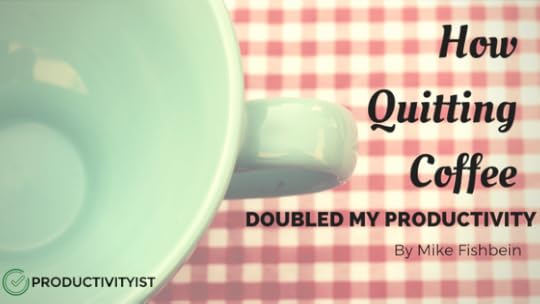
This guest post is by Mike Fishbein. Mike is a bestselling author and digital marketing consultant. He shares unique personal development ideas at mfishbein.com .
I’ve always been a big coffee drinker. I would drink it every morning, right after waking up. Coffee has given me the energy to write hundreds of articles and to consult with over a dozen companies on marketing over the years. Coffee has made me more alert and seemingly smarter.
However, at the end of 2016, I noticed that my coffee intake had increased significantly. I had to work on multiple projects, and each one had an aggressive deadline. There was no time to rest, and I had to barrel through. So I kept drinking more coffee throughout the day and even into the night.
Drinking more coffee worked—temporarily. It helped me finish up those projects. However, coffee was only a temporary mask to my underlying problems. By Christmas morning, I was completely shot. Burnt out. Stressed. And I was dependent on coffee to get me through what would have otherwise been an incredible morning with my family.
I had to quit.
Acknowledging my past failures at breaking habits, I didn’t try to stop drinking caffeine completely on day one. I started small. For the first three days, I drank several cups of black tea. For the next three days, I drank several cups of green tea. Since then, I’ve only been drinking one cup of green tea per day.
I was worried that quitting coffee would hurt my productivity. Instead, my focus has been stronger, and my energy levels are more consistent throughout the day. Here are the three ways quitting coffee has helped me and what I’m doing now to increase my productivity.
1. Play The Long Game
Entrepreneurship is stressful. There’s always something you could be doing. The fear of failure is very real. But I’ve been in the game long enough to:
Differentiate between what’s urgent and what can wait
Understand the importance of thinking long-term
I accept the fact that I can’t work 100 hour weeks for extended periods of time. Working a 100 hour week is like borrowing energy from other weeks. I’ll eventually have to pay it back with a period of burn out. I get that some people — the Elon Musks of the world — can consistently work 100 hours per week throughout their careers. I’m not one of those people.
If you need coffee to get all your work done, you may not have an energy level problem. Rather, you might have a problem with your workload, your management practices or the deadlines you’re setting for yourself. Question your assumptions before assuming more coffee is the answer.
2. Upgrade Your Physical Health
If you need coffee to have sufficient energy, the coffee may be masking opportunities for improving your physical health. You’ve probably read articles about how bad most people’s diets are today. I used to have a horrible diet, too. In grade school, I ate pizza for lunch every single day.
However, I’ve been iteratively improving my diet and exercise regimen over the past several years. Now that I’m not drinking coffee, I can observe the positive and negative effects that various foods and workouts have on my body. Coffee is not masking feelings of fatigue or giving me energy that I would have otherwise attributed to healthy food.
If you find yourself lacking energy or focus, try upgrading your diet and/or exercise regimen. Of course, this can give you benefits far beyond productivity.
3. Focus On Focus
Yes, without coffee, I have less energy. However, the energy I gained from coffee was often a nervous energy that led me to act more impulsively. In the early afternoons, I find myself lacking energy, but not having that nervous energy helps me focus. I switch tasks less and take more time to make decisions.
The energy I gained from coffee also had peaks and valleys. Right after drinking a cup of coffee, I definitely had more energy. But a few hours after drinking a cup of coffee, I had less energy than I did before drinking it. This is part of what lead me to drinking so much coffee. When I need a pick me up, I go for a walk outside. I’ll drink some water or have a healthy snack. I find all of these options to be very helpful.
The takeaway here is that more energy does not always equate to increased focus or productivity. Your output is the metric that matters. By improving my levels of focus, I increased my output.
How You Can Have More Focus Too
If you find yourself dependent on coffee to be productive, consider managing your workload in a more practical manner or upgrading your physical health. Eat foods that give you energy, exercise regularly and get plenty of sleep. Start small and reduce your coffee intake slowly over time. Replace coffee intake with tea as needed. Quitting coffee has improved my focus and given me more stable and sustainable energy levels. I hope it does for you too.
Have you ever given up coffee or cut down on your coffee intake to boost your productivity like I have? Please leave a comment. Thanks!
The post How Quitting Coffee Doubled My Productivity appeared first on Productivityist.
March 14, 2017
Stop Putting So Much Stuff On Your To-Do List
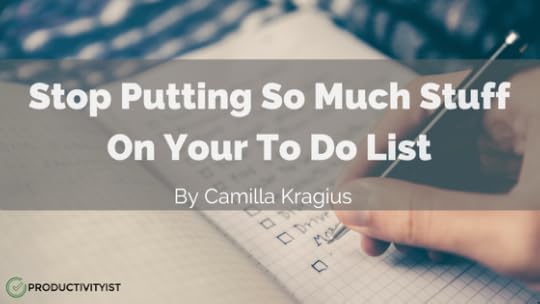
This guest post is by Camilla Kragius. Camilla is the founder of No More Hamster Wheel. She loves to teach people how to work smarter instead of harder, to start living and to excel their life. You can connect with her on Facebook.
When you use a to-do list, you know the feeling you get when you are unable to complete all of the items on it.
In some cases, your to-do list may even get longer during the day.
It’s time to change this approach.
How can we do this?
It’s time to make shorter to-do lists.
Crossing things off as you finish them gives you a great sense of accomplishment. And this is a good because we want to feel accomplished. The problem is not crossing things off.
Rather, the problem is the false sense of being productive by crossing something off.
Our society has made being productive synonymous with being busy. Working long hours or always doing something is viewed as if you’re being productive.
Being busy doesn’t mean you’re being productive.
Quite often, it’s the opposite. You’re busy, but you’re not productive. Busyness leads to the feeling of never having enough time to do the things you want to do.
And that is really disheartening, right?
Are You Working On the Right Things?
To-do lists have become a dumping ground for anything and everything. While there is no doubt that getting things on paper (instead of holding it in your head) is a good thing, what seldom happens is any thought as to why these things are on your to-do list.
So start asking yourself why a task is on your to-do list. Then take it one step deeper by asking what purpose the task serves.
Is it an essential task that will make a difference in your life or is it what I call a stocking stuffer? A stocking stuffer is a task that keeps you busy, but it is not essential. A stocking stuffer only keeps you distracted from working on tasks that would move you forward both personally and professionally.
It’s Time For a Short, Focused To-Do List
I teach my clients to do what I call a brain dump. Instead of using their to-do list as their dumping ground, they actually create a specific place for it. Just dump everything there, and then use that as a base to create either a daily or a weekly to-do list.
Not just any to-do list…but one that is super short and focused.
Suddenly, each item on the to-do list has a purpose. Each item can be lined up in order of priority and can be scheduled to be done that day or that week.
What Gets Scheduled Gets Done
A huge reason why people don’t get everything done they set out to do (even if they have a short and focused to-do list) is because it’s not on their calendar.
We are masters at underestimating how long a task will take us. We only look at the list of to-do’s, and then it’s easy to think we can get those tasks done on a given day. But it’s only when we block out time on our calendar that we get a correct picture of what can be accomplished.
I’m challenging you right now to take your to-do list and try to fit it in on your calendar. Between life, meetings, errands and everything else that needs to be taken care of, my guess is that your to-do list is a bit overambitious.
This is why putting your to-do’s on your calendar is so effective. It gives you a visual view of your day and what you realistically can accomplish. This approach also forces you to prioritize better.
How important is that task if it means you won’t have time to go exercise?
How important is that task if crossing it off requires skipping lunch?
How important is that task if it will only make you more tired and unfocused (because you’re already exhausted)?
How important is that task if it requires staying up late and not getting enough sleep?
How important is that task if it cuts into quality time with friends and family?
Feeling accomplished by crossing things off of a list is great, but if it comes at the cost of missing out on important parts of life, how is that an accomplishment?
It takes a shift in mindset to start working in a productive way, instead of a busy way. Give yourself time to enjoy life. In many cases, this approach requires going against what society has told us. It means that others may think you’re lazy because you’re not as “busy” as they are.
It’s time to change your thinking. It’s time to work on the things that are truly important to you. It’s time to be productive…not busy. It’s time to get rid of that long to-do list.
The post Stop Putting So Much Stuff On Your To-Do List appeared first on Productivityist.
March 13, 2017
The Productivityist Podcast: Kitchen Prep and Productivity Allison Schaaf
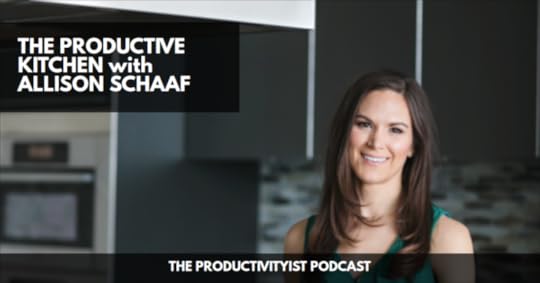
In this week’s episode, my guest is Allison Schaaf – a food, nutrition and culinary expert, and founder of meal-planning website PrepDish. It offers gluten-free, dairy-free and paleo meal plans to help people save time preparing healthy, homecooked meals.
Allison was a guest on a previous bonus episode where we chatted about her approach in productivity which got its roots from the kitchen. She’s back this week and talked about something that’s off the beaten path for me: cooking!
If you’re interested in having a more productive kitchen, I highly suggest paying attention to this episode as we discussed:
Her background in culinary arts and nutrition, her stint as a personal chef, and a personal pain point that led her to create a meal plan system which is now known as Prep Dish (2:42).
The importance of nourishment and well-being, and why people should invest time planning their meals instead of going for the convenience of fast, commerically-prepared food (7:18).
How to create meal plans that cater to people with different diet preferences and restrictions (9:57).
How the PrepDish meal plan works – what’s in it, how tos, and the strategies that will help you master food preparation and healthy cooking. (11:57).
Allison’s food preparation hacks like prioritization, doing double-duty tasks, grouping and batching, and how it’s parallel to my own productvity system (18:10).
How learning the PrepDish system can help you enjoy the reward of healthy cooking in your family. (21:12).
Allison’s kitchen essentials and why you shouldn’t skimp on the right tools (24:18).
Allison’s advice that will make a difference in your life (29:12).
Relevant Links:
PrepDish.com
Three Must Have Knives for Your Kitchen | PrepDish.com
Three Essential Cutting Boards You Need in Your Kitchen | PrepDish.com
Prepping Ahead & Storing | PrepDish.com
Food Processor vs. Blender? My Recommendation. | PrepDish.com
Prep Dish (@PrepDish) | Twitter
Anova Culinary PCB-120US-K1 Bluetooth Precision Cooker | Amazon
Instant Pot IP-DUO60 7-in-1 Multi-Functional Pressure Cooker | Amazon
Thanks for listening! Until next time, remember to stop guessing…and start going.
If you’re interested in supporting the podcast and receiving exclusive content while doing so, you’ll want to check out the patrons-only version of The Productivityist Podcast on Patreon. Also, remember to leave The Productivityist Podcast a rating and review on iTunes, or on whatever platform you’re listening to. I read every single bit of feedback we receive. I want to make this show better and with your help I can do just that.
The post The Productivityist Podcast: Kitchen Prep and Productivity Allison Schaaf appeared first on Productivityist.
March 9, 2017
5 Ways To Improve Work-Life Balance When You Work At Home
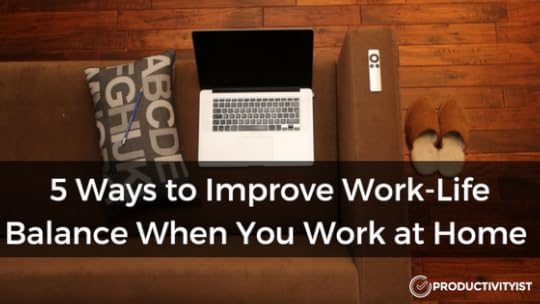
Micheal Gilmore is a blogger and editor at Resumesplanet.com. He enjoys writing about business, marketing, productivity and personal growth. In his parallel life, he loves hiking and can’t wait to see the Himalayas one of these days.
Whenever I say that I’m working as a freelancer writer, people around me believe that working from home is easy. That it takes less effort than a regular full-time job and gives you more time to live your life.
There are some definite benefits such as working whenever I want and having a flexible schedule. BUT…the truth about working from home is far from what people believe.
If you’re a professional who chose to go on this path, you likely have already realized that distractions and life often stand in your way. Creating harmony in your life is difficult when working for yourself. When you’re on your own, there are many things that drag your productivity down.
And so the unproductive cycle begins. When you’re no longer productive, you become stressed out. Your conscience screams out loud. Then you decide to work harder. The next thing you know – your life is completely out of balance. You start neglecting other areas of your life, and that’s never good.
So what’s the solution? Simple: find and cultivate a work-life balance system that works best for you. It must suit your lifestyle and yours only. In order to find this balance, you must go through a trial-and-error process. This process consists of failing, getting back up, failing again, getting back up again, and eventually succeeding.
Here are five effective insights that should help you create a better work-life balance while working from home:
1. Plan Your Activities Properly
Your planning should start off with a goal setting process. You must develop long and short term goals that are interconnected. Let’s say you set three yearly goals. Put down a list of wishes and select which one you’d like to become a reality. After you have these three big goals, create monthly goals according to your yearly goals.
Then, continue with the weekly and daily ones. Each of the three daily goals that you set must be firstly connected to your weekly goals, then to your monthly goals, and ultimately to your yearly goals.
You’ll come across setbacks and challenges, and you must always overcome them. If you manage to stay committed and extremely focused on your objectives, you’ll have peace of mind, and you’ll be able to give more time and attention to other parts of your life.
2. Protect Your Work Time
Do you know who your biggest enemy is? If you haven’t realized by now, it’s you…and just you. We often sabotage ourselves by performing under our expectations. Our mindset also carries a huge role when it comes to organizing time. If you want to stay productive—and also maintain your work-life balance—you must assess your time spending habits.
Secondly, you must learn how to say no. Your closest ones will always expect you to be there, but you shouldn’t always comply with their requests. The biggest problem comes when you give your time to people who don’t even deserve it or are not even that close to you.
If you want to perform well, you must treat your time with respect. Time is the only resource that never comes back, and it’s your most valuable asset. If you manage to stay focused and be productive in your work time, work-life balance will improve because you’ll have time for other things.
3. Take Close Care of Your Health
Your physical and mental health should never be neglected. No matter what type of job you have, working from home can be very tricky. The stress you accumulate is going to influence your mental health in the long-term. As you know, staying all day in front of a computer will make you go insane. This is why it is important to have a good nutrition plan, exercise regularly, and pay attention to your condition.
If your energy levels are low, you must change some aspects of your life. Less sugar, fewer chemicals, more vitamins, and healthier foods is a great approach to try.
4. Take Intentional Time Off
You should never overwhelm yourself with your work. When you are overwhelmed, your productivity decreases, and soon the harmful cycle mentioned above starts over. Disconnecting from your work is the best way to remain consistent and committed to what you do.
Spend more time in nature, change your workplace environment, or do an activity you enjoy. Working less—but with more passion and focus—will turn out to be more productive for you rather than working more hours each day.
5. Always Start Your Day Strong
The first hours of each morning are critical to your success. This time influences your entire day. Treat these hours with respect to ensure higher productivity levels and more balance. A morning routine where you follow the same steps each day helps create small but efficient habits. For example, whenever I jog in the morning, I choose to listen to an instructional audiobook. I strengthen my body and mind at the same time and feel a great sense of accomplishment and momentum.
Make the morning yours, and don’t let anyone interrupt you. Leave your e-mails for later. Answer that important message in a few hours. Don’t allow helpful tools to control you. Remember, you are the one in charge.
Conclusion
Maintaining a work-life balance is important for your health, happiness, and your overall wellbeing. You can’t expect to live a good life if you’re neglecting your relationships and spend all of your time focused on work.
Balance does not come overnight. Work within your routines as much as possible and keep making small adjustments to improve. Eventually, each habit will become natural, and you will start to see growth in many areas of your life.
The post 5 Ways To Improve Work-Life Balance When You Work At Home appeared first on Productivityist.
March 7, 2017
The Key To Personal Productivity
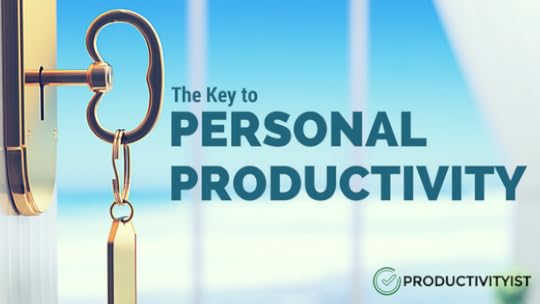
This guest post is by Productivityist team member Jim Woods. He is a writer, content editor, and Productivityist Coaching Practitioner. You can connect with him @jimwoodswrites on Twitter or his website jimwoodswrites.com
It’s really easy to get lost in the sea of productivity apps.
Don’t get me wrong; there are some AMAZING apps out there.
But no app can ever replace your instincts.
You know when something isn’t working.
You know when you’re REALLY procrastinating.
You know what to do next.
Even if you don’t know what to do next right now, you know what steps you can take to figure out the problem.
The real productivity problem many of us have is surprisingly simple…we are not totally honest with ourselves.
This problem manifests itself in many ways.
Let’s say a notification pops up on a screen in front of you.
You ignore the notification at first because you know there’s no chance you’ll be doing that item today.
So you hide (or continue to ignore) the notification.
Then it pops up again.
And then more notifications pop up.
Maybe you even mark the notification(s) off as “done” so it goes away.
But the task is not done, right?
Uh-oh.
There’s another problem here.
Your to-do list is too long and not realistic.
As you know, your to-do list likes to grow as the day goes on, right?
You go to a meeting and now your to-do list is even longer.
And you keep hoping things will get better, but they don’t.
Personal productivity goes haywire when you’re not honest with yourself.
That’s why it is critical to focus on “personal productivity” not just “productivity.”
You know if you are completely honest with yourself.
Use your intuition.
Listen to that voice in your head.
We all have a constant inner dialogue going on in our heads.
What is your inner voice telling you?
I’m tired of being overwhelmed. I need to get some help.
I need to talk to my boss about reducing the number of meetings we have.
I’m looking for a new app because…I’m really procrastinating.
I think I’m afraid of this task. I think I’ll mess it up.
I’m on Facebook because I’m bored and tired. I should just go to bed.
Personal productivity problems are best handled when you get to the root of the problem.
Be willing to say, “I’m on Twitter now because I’m feeling lonely and a bit disconnected from others right now.”
This kind of honesty doesn’t come overnight. But if you journal, it often helps.
Journaling is a great way to start emptying out your thoughts.
No productivity method or app can replace you.
You’re the one that is in charge.
There is no perfect app out there that will solve all of your problems.
But here’s the great news: you can solve your problems.
Maybe it’s time to remove some items from your to-do list, hire an assistant, book a productivity coaching session or reassess your priorities.
You know what to do.
The more honest you are with yourself, the better decisions you’ll make.
Focus on doing the right things, not just more things.
Can you relate to this? I’d love for you to share your thoughts in the comments.
The post The Key To Personal Productivity appeared first on Productivityist.
March 6, 2017
The Productivityist Podcast: Automating, Growing, and Selling with Joshua Latimer

In this week’s podcast episode, my guest is Joshua Latimer – the man behind Send Jim and Automate Grow Sell, which help small businesses tap the power of relationship marketing.
A few years back, Joshua left his job as a banker at JP Morgan Chase and decided to open a cleaning business in Michigan, which he eventually sold in 2015. He is now based with his family in Costa Rica managing a company that creates more freedom for businesses through automation and systems.
Joshua and I chatted about planning, systemizing, theming, and automation among many others. Topics we’ve discussed are:
Joshua’s business background, the different business models that inspired him, his motivation to create Send Jim, and it’s 4-year run as a business (2:20; 3:19; 4:41).
The importance of relationship marketing in businesses and how Send Jim can help entrepreneurs harness its power. (6:55).
How he applies theming in his personal life and even created themed days for each of his family member (9:39; 11:18).
Joshua’s task management approach to the multiple projects he is running (12:33; 13:10; 14:00).
His fascination with different beliefs, points of view, and economic and business principles across cultures (18:50).
Books that captivated his interest and shaped the core paradigms he is currently applying in his business and life (20:16).
Why he turned down an offer to co-author a book and a lesson about saying no. This resonated with me a lot (22:50).
Other methods he has put into place like breaking his days into sprints, delegating, and turning things off (25:45).
What Send Jim does, its market, and why it’s called Send Jim instead of Send Josh (27:21).
Relevant Links:
Features | Sendjim.io
Send Jim | App Store
Automate Grow Sell | Joshua Latimer
Beyond the E-Myth with Michael E. Gerber | Productivityist
Automate Grow Sell | Joshua Latimer
Productivity Planner: Get More Done and Beat Procrastination by Intelligent Change | Kickstarter
The ONE Thing: The Surprisingly Simple Truth Behind Extraordinary Results by Gary Keller and Jay Papasan | Amazon
Essentialism: The Disciplined Pursuit of Less by Greg McKeown | Amazon
Thanks for listening! Until next time, remember to stop guessing…and start going.
If you’re interested in supporting the podcast and receiving exclusive content while doing so, you’ll want to check out the patrons-only version of The Productivityist Podcast on Patreon. Also, remember to leave The Productivityist Podcast a rating and review on iTunes, or on whatever platform you’re listening to. I read every single bit of feedback we receive. I want to make this show better and with your help I can do just that.
The post The Productivityist Podcast: Automating, Growing, and Selling with Joshua Latimer appeared first on Productivityist.



